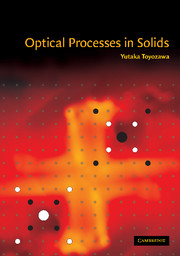Book contents
- Frontmatter
- Contents
- Preface
- Acknowledgments
- List of principal symbols
- 1 Radiation field
- 2 Quantum mechanics
- 3 Interaction of radiation with matter
- 4 Electronic vs. nuclear motions and the optical spectra of localized electrons in solids
- 5 Lattice vibrations
- 6 Electric susceptibility and dielectric constant
- 7 One-electron states in solids
- 8 Excitons
- 9 Polaron and the self-trapped state
- 10 Optical spectra of exciton in the phonon field Overview
- 11 Higher-order optical processes
- 12 Inner-shell excitation
- 13 Photo-induced structural changes
- 14 Light, matter and life (A scenario for the origin of life and its evolution)
- Appendix 1 Derivation of exciton Hamiltonian from many-body Hamiltonian
- Appendix 2 Transient spectra for second-order optical processes
- References (by chapter)
- Subject index
10 - Optical spectra of exciton in the phonon field Overview
Published online by Cambridge University Press: 10 December 2009
- Frontmatter
- Contents
- Preface
- Acknowledgments
- List of principal symbols
- 1 Radiation field
- 2 Quantum mechanics
- 3 Interaction of radiation with matter
- 4 Electronic vs. nuclear motions and the optical spectra of localized electrons in solids
- 5 Lattice vibrations
- 6 Electric susceptibility and dielectric constant
- 7 One-electron states in solids
- 8 Excitons
- 9 Polaron and the self-trapped state
- 10 Optical spectra of exciton in the phonon field Overview
- 11 Higher-order optical processes
- 12 Inner-shell excitation
- 13 Photo-induced structural changes
- 14 Light, matter and life (A scenario for the origin of life and its evolution)
- Appendix 1 Derivation of exciton Hamiltonian from many-body Hamiltonian
- Appendix 2 Transient spectra for second-order optical processes
- References (by chapter)
- Subject index
Summary
Overview
In this chapter, we will be concerned with one of the principal subjects of this book, the spectroscopic study of microscopic dynamical processes in matter, with the exciton in the phonon field as a model system. The linear response of matter to an electromagnetic wave of definite frequency reveals a component, with the same frequency, of the motion of the charged particles (electrons and nuclei) in the matter. The linearity of this response is usually assured under not-too-intense light due to the weak radiation–matter interaction. Therefore, the frequency dependence of the linear response such as the lineshape of absorption spectra (imaginary part of susceptibility apart from an unimportant factor), tells us what is going on in the microscopic world.
Both light and matter have the dual nature of wave and particle and obey the uncertainty principle of quantum mechanics, facts which govern all aspects of the spectroscopic study of matter. An exciton, a typical elementary excitation in an insulating solid, behaves as a quasi-particle with definite dispersion (energy–momentum relation), and can be created by annihilation of an incoming photon. Due to the energy–momentum conservation rule, this elementary process can take place only with a photon with definite energy equal to that of the exciton with the same wave vector; namely, the absorption spectrum consists of an infinitely sharp line. Monochromatic light with infinite duration time corresponds to an exciton with definite energy and hence infinite lifetime.
- Type
- Chapter
- Information
- Optical Processes in Solids , pp. 192 - 238Publisher: Cambridge University PressPrint publication year: 2003



